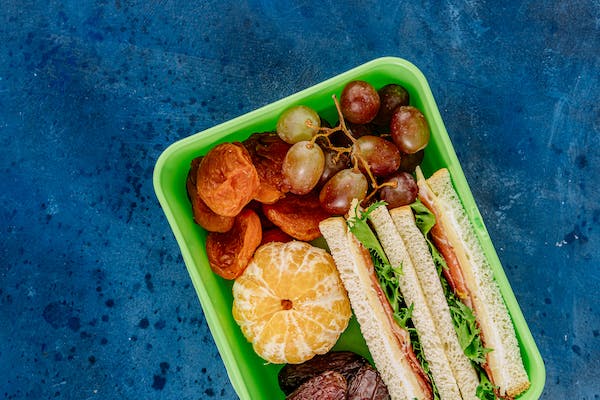So I know I’ve spent some time recently talking about the things you might not want to feed your kids (like Veggie Straws or their school lunch).
This month, I’m going to focus on discussing what you CAN feed them!
The following cheat sheet is meant to take some of the guesswork out of what to pack (though there may be times you prefer to make substitutions as you learn what your child likes). Over the next few weeks, I’m going to focus on just one section at a time- no need to overhaul the whole thing at once!
Just make sure to subscribe so you don’t miss a post in the series!
All of the meal options I’m going to cover in this series are focused around getting more fruits, veggies, and whole grains into your kids since those are the areas that I most often advise on in my nutrition coaching practice. We’re shooting for:
- 2-4 servings of fruit
- 3-5 servings of veggies
- 6-11 servings of whole grains
Part of the reason many children are deficient in these areas is that the average American child eats more than the recommended servings of meat and dairy each day (only 2-3 servings of each). For that reason, meat and dairy will not be emphasized here.
Today’s Takeaway: Protein/Fiber/Fat in Snacks
Got kids who ALWAYS seem to be hungry? Some of that is normal, but having a balance of protein/fiber/fat at each meal can help with filling those bottomless pits.
If we look at the “snack” category in the diagram, you’ll notice I’ve included a serving of fruit along with a protein/fiber/fat item (many plant-based protein sources contain all three whereas typical snacks like cheese sticks or sugary fruit snacks do not). When all three of these items are combined, you get a quick pick-me-up from the carbohydrates in the fruit but sustained energy from protein and fat (since your body takes longer to use them). When served with water, fiber will puff up in the belly like a sponge, also adding to a feeling of fullness.
Ideally, kids should have snacks between meals to keep from going too long without food but sometimes school schedules don’t permit it. If this is the case for your family, increase the serving size to make up for the skipped snack or add a whole grain tortilla to wrap the snack up in (really yummy with bananas and peanut butter!).
Whole banana with plain, shelled sunflower seeds.
Suggestions for adding protein/fiber/fat to snacks include:
- 1/4 to 1/2 cup whole plain or salted nuts and seeds (or nut/seed butter smeared on the fruit, such as apples or bananas)
- 1/2 cup granola cereal or 1 granola bar (look for one under 10 grams of sugar)
- 1/2 cup edamame (great when paired with mandarin oranges)
- 1/2 cup baked, seasoned chickpeas
- Hummus or bean spreads with whole grain crackers (swap the side of fruit for veggies if your kids aren’t opposed)
That’s it- simple! If it’s too complicated it’s harder to stick with- I know we all adore those fancy little bento lunches but honestly, most of us don’t really have time for that!
In the upcoming weeks, we’ll move on to simple (tasty!) sides and entrees that will allow you to have lunch done in under 7 minutes. Stay tuned!
Question: What about muffins?
Most commercially available baked goods are LOADED with sugar and nearly devoid of fiber. If you like to bake and want to make muffins with whole grain flower, veggies, fruit, and very little sweetener, you could probably opt for adding a baked good into the snack rotation. I’ve got a few good veggie muffin selections on Pinterest.
Try it Out: Snack Sampling Party
Now it’s your turn to put this into practice! This week, have a “new snack” sampling party at home and allow your kids to choose what goes into their new school snack rotation. Even if they only pick one or two new items, that’s a victory! Variety might be the spice of life to us but for kids, routine is everything.
Share your findings! Are you struggling with making the switch? Comment below- we’d love to help!

